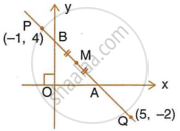Advertisements
Advertisements
Question
(1, 5) and (–3, –1) are the co-ordinates of vertices A and C respectively of rhombus ABCD. Find the equations of the diagonals AC and BD.
Solution
A = (1, 5) and C = (–3, –1)
We know that in a rhombus, diagonals bisect each other at right angle.
Let O be the point of intersection of the diagonals AC and BD.
Co-ordinates of O are
Slope of AC =
For line AC:
Slope = m =
Equation of the line AC is
y – y1 = m(x – x1)
2y − 10 = 3x − 3
3x − 2y + 7 = 0
For line BD:
Slope = m =
(x1, y1) = (−1, 2)
Equation of the line BD is
y – y1 = m(x – x1)
3y − 6 = −2x − 2
2x + 3y = 4
APPEARS IN
RELATED QUESTIONS
In the given figure ABCD is a rectangle. It consists of a circle and two semi-circles each of
which are of radius 5 cm. Find the area of the shaded region. Give your answer correct to
three significant figures

Using a graph paper, plot the points A(6, 4) and B(0, 4).
- Reflect A and B in the origin to get the images A' and B'.
- Write the co-ordinates of A' and B'.
- State the geometrical name for the figure ABA'B'.
- Find its perimeter.
A straight line passes through the points P(–1, 4) and Q(5, –2). It intersects the co-ordinate axes at points A and B. M is the mid-point of the segment AB. Find:

- The equation of the line.
- The co-ordinates of A and B.
- The co-ordinates of M.
Show that A(3, 2), B(6, −2) and C(2, −5) can be the vertices of a square.
- Find the co-ordinates of its fourth vertex D, if ABCD is a square.
- Without using the co-ordinates of vertex D, find the equation of side AD of the square and also the equation of diagonal BD.
O(0, 0), A(3, 5) and B(−5, −3) are the vertices of triangle OAB. Find the equation of median of triangle OAB through vertex O.
P(3, 4), Q(7, –2) and R(–2, –1) are the vertices of triangle PQR. Write down the equation of the median of the triangle through R.
Point A and B have co-ordinates (7, −3) and (1, 9) respectively. Find:
- the slope of AB.
- the equation of perpendicular bisector of the line segment AB.
- the value of ‘p’ of (−2, p) lies on it.
A line is of length 10 units and one end is at the point (2, – 3). If the abscissa of the other end be 10, prove that its ordinate must be 3 or – 9.
Use a graph sheet for this question, take 2 cm = 1 unit along both x and y-axis:
- Plot the points A (3, 2) and B (5, 0). Reflect point A on the y-axis to A΄. Write co-ordinates of A΄.
- Reflect point B on the line AA΄ to B΄. Write the co-ordinates of B΄.
- Name the closed figure A’B’AB.
